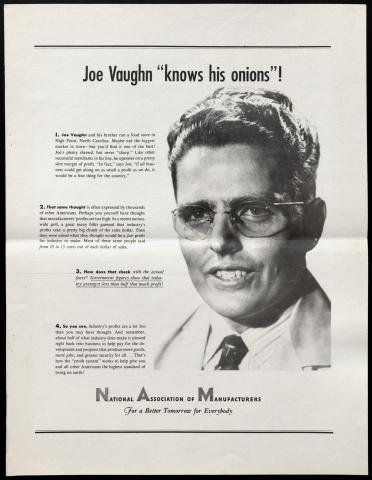
I always did say that about Joe Vaughn. Knows his onions.
This 1947 advertising proof is from a public relations campaign organized by the National Association of Manufacturers to influence popular perception and opinions about corporate profits.
The National Association of Manufacturers (NAM) was organized in Ohio in 1895 in response to the Panic of 1893, with the goal of recovering from the economic depression, protecting American goods from foreign competition, and to promoting trade expansion. The organization continues today as the largest manufacturing association in the United States.
Originally, NAM was an organization of associations (such as local boards of trade, chambers of commerce, industrial associations, and trade associations), individual manufacturers being only secondary or cooperating members. However, within a couple of years, in order to represent manufacturing interests adequately, membership support would need to be primarily based on individual manufacturers.
By the time this ad campaign was launched, NAM had become an active voice in lobbying federal officials to shape legislative policies favorable to business interests. In the later 1930s and 1940s, NAM worked for the repeal of the National Labor Relations Act, or the Wagner Act, which guaranteed employees the right to organize into trade unions, engage in collective bargaining, and take collective action such as strikes, as well as places a ban on company unions. In 1948, their efforts were partly realized with the passage of the Taft-Hartley Act, which restricted the activities and power of labor unions.
During this time, NAM focused on economic education as it sought to counter what many business leaders identified as the collectivist tendencies of post-war liberalism (powerful government, high taxes, strong labor unions, and anti-big business sentiment). Its most successful economic education programs included: “How our Business System Operates,” and “Our American Heritage.” Another program of this sort was a clergy-industry relations program that sought to transmit a greater understanding of national issues through clergymen. NAM’s publication Dateline reached more than 30,000 clergymen.
Hagley Library's digital collections of NAM material draws selections from our collections of National Association of Manufacturers photographs and audiovisual materials (Accession 1973.418), National Association of Manufacturers Records (Accession 1411), and items in our Published Collections department. To view this collection online now in our Digital Archive, click here.

